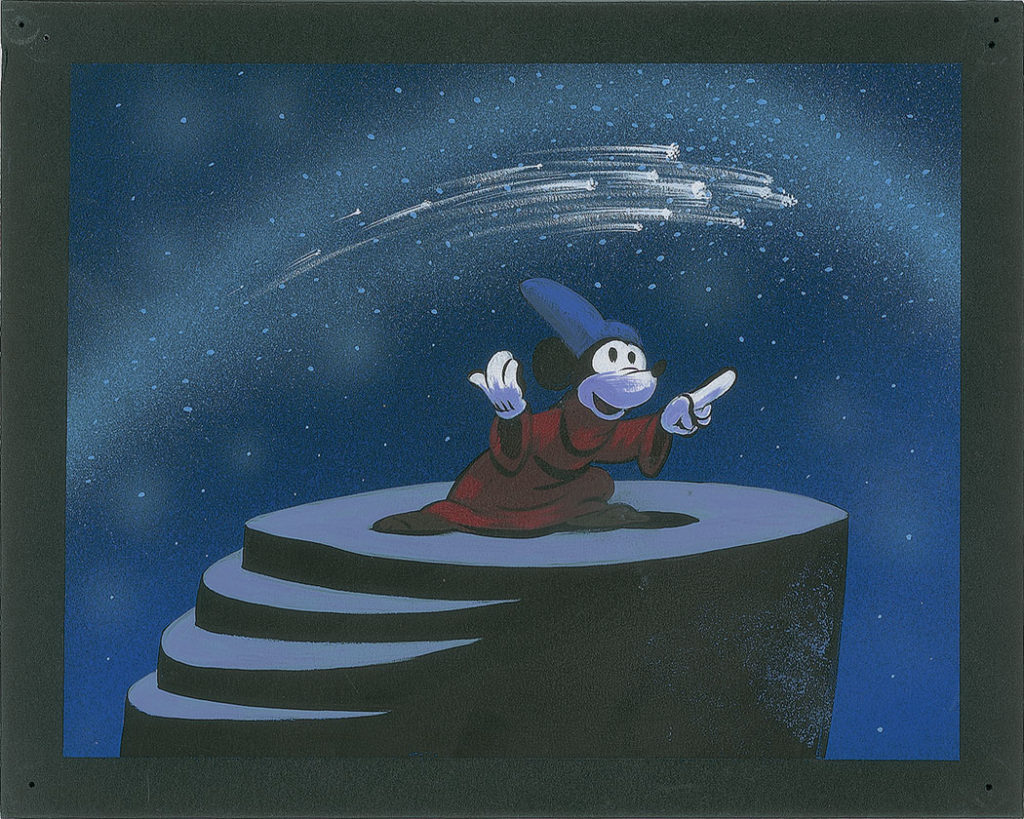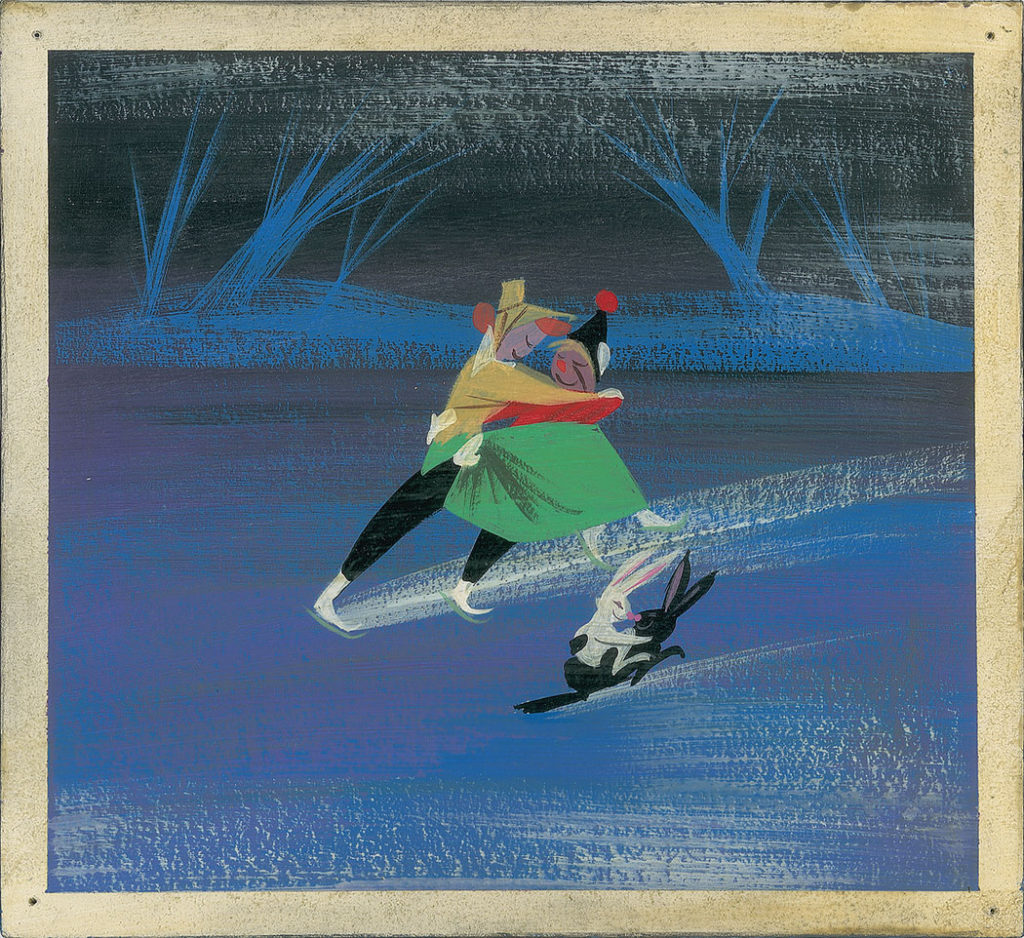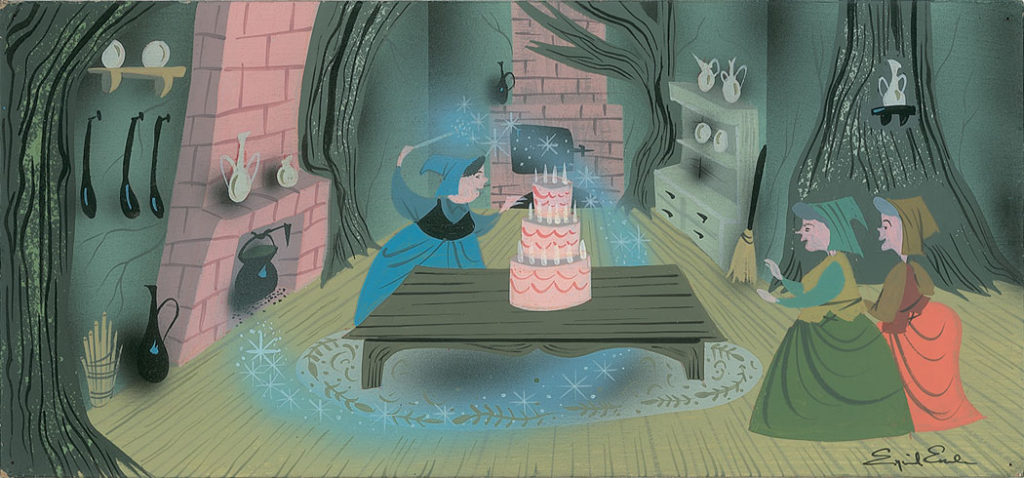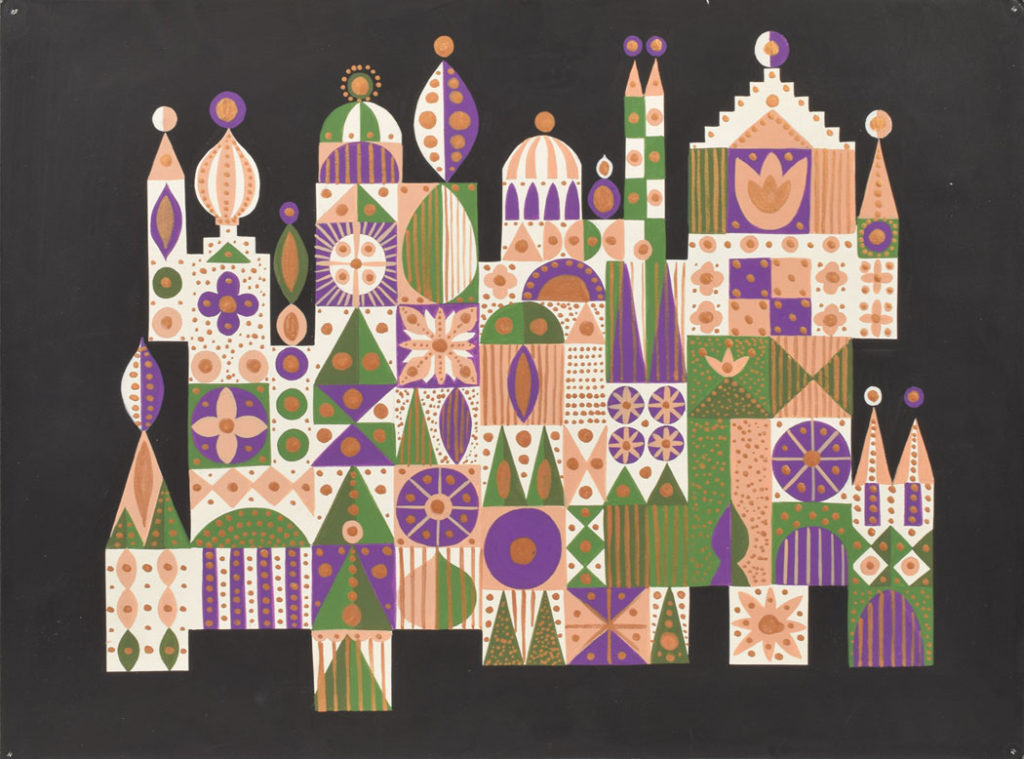How did the iconic scenes in Disney animated films take shape? Snow White running away through a haunted wood. Sorcerer’s Apprentice Mickey conjuring in “Fantasia.” Cinderella’s magical pumpkin coach galloping toward Prince Charming’s castle. The prince leaning down to awake “Sleeping Beauty” with a kiss.
They began as stories that were manifested as concept art—a selection of which is included in an auction of animation cells, model sheets and storyboard drawings from Disney, Hanna-Barbera and other studios through Dec. 6, 2017, at RR Auction of Amherst, New Hampshire, and Boston. The sale includes paintings and drawings by two of the Disney studio’s most iconic concept artists: Mary Blair, who shaped the look of projects from “Cinderella” (1950) to Disneyland’s “It’s A Small World” (1964), and Eyvind Earle, who is best known for developing the striking illuminated manuscript style of “Sleeping Beauty” (1959).
In the 1930s, as Walt Disney sought to create ever more ambitious animations, on the way to creating the California film studio’s first full-length animated feature film “Snow White and the Seven Dwarfs” (1937), the studio assigned artists to the new position of (what is now called) concept artist. Their job was to sketch the very first imaginings of what the characters, the scenes, the films would look like. Their preproduction work wasn’t intended for the screen, but to inspire their colleagues. In their paintings and drawings, you find the first sparkling seedlings of what blossomed into classic scenes.
Mary Blair (1911–1978) was a landscape painter in a 1930s Depression era Regionalist mode before going to work for the Disney studio. But her art was transformed by an eye-opening trip to Mexico and South America as part of a Disney team in 1941.
“There is a difference in feel down there, in the colors, the smells, the tastes. I think they were all inspired by it. She was particularly inspired by it,” said John Canemaker, who organized the exhibition “Magic, Color, Flair: The World of Mary Blair” that originated at San Francisco’s Walt Disney Family Museum in 2014 and was on view at The Eric Carle Museum of Picture Book Art in Amherst in 2016. “It kicked off like a stick of dynamite.”
Blair became a brilliant modernist colorist for the studio. She helped develop the hues and moods of “Cinderella” (1950), “Alice in Wonderland” (1951) and “Peter Pan” (1953). She left the studio to pursue illustration, on the heels of creating her masterpiece Golden Book “I Can Fly” with author Ruth Krauss in 1951. Walt Disney himself recruited her back in 1964 to help design the “It’s a Small World” ride and other attractions at Disneyland in California and Disney World in Florida.
Eyvind Earle (1916-2000)—currently the subject of a major retrospective at San Francisco’s Walt Disney Family Museum through Jan. 8—is best known for developing the ornate illuminated manuscript look of “Sleeping Beauty,” for which he worked as lead stylist.
“I wanted stylized, simplified Gothic Straight tall perpendicular lines like Gothic cathedrals,” Earle once said. “I made a medieval tapestry out of the surface whenever possible.”
Earle joined the Disney studio in 1951 as an assistant background painter and made concept art for “Lady and the Tramp” (1955) and “Peter Pan” (1953). His dazzlingly decorative graphic designs are part of an early 20th century Modernist American mode, a cousin to the styles of Grant Wood and Virginia Lee Burton. He left the studio prior to “Sleeping Beauty”’s theatrical release and founded his own animation company.

Attributed to Albert Hurter: Concept drawing from “Snow White and the Seven Dwarfs” (1937). Pencil on off-white animation paper.
“Albert Hurter (1883-1942) was the first-ever inspirational sketch artist to work at the Walt Disney Studio, and he is most famous for his significant contribution to the visual styles of ‘Snow White and the Seven Dwarfs’ and ‘Pinocchio,’” according to RR Auction. The Swiss-born artist joined the studio in 1931, is also credited with originating the sailor-suit look of Donald Duck.

Mickey Mouse concept painting from “Fantasia” (1940). Tempera on black 9 x 7 artist’s board.
Mickey Mouse plays the ‘Sorcerer’s Apprentice” in the dream sequence as comets streak above in the night sky.

Mary Blair: Jenny and Joe concept painting from “Melody Time” (1948). Tempera on 8.5 x 8 artist’s board.
The lovers Jenny and Joe skate with two rabbits mimicking them in this sketch for the “Once Upon a Wintertime” segment of the omnibus film.

Mary Blair: Cinderella’s coach concept painting from Cinderella (1950). Tempera on 22 x 8.5 artist’s board.
Blair’s painting depicts Cinderella’s coach arriving at castle for Prince Charming’s ball.

Eyvind Earle: Flora, Fauna and Merryweather concept painting from “Sleeping Beauty” (1959). Tempera on 12 x 5.5 artist’s board.
The three fairy godmothers prepare a cake for the 16th birthday of Princess Aurora (aka Briar Rose) in their hidden forest cottage. In the film, years before, the evil Maleficent had cursed the girl, saying that she would prick her finger on a spinning wheel and die before the end of that day.

Eyvind Earle: Sleeping Beauty and Prince Phillip concept painting from “Sleeping Beauty” (1959). Tempera on 23 x 9.25 artist’s board.
“Disney gave him a significant amount of freedom in designing the settings and selecting colors for the film. Earle also painted the majority of the backgrounds himself, and his stylistic influence is readily apparent in the final product. This particular painting came to be the model for the cover design of the Sleeping Beauty ‘Big Golden Book,” according to RR Auction.

Mary Blair: “It’s a Small World” façade concept painting, c. 1963. Tempera on 20 x 15 artist’s board.
Blair was instrumental in coming up with the look and feel of the ‘It’s a Small World’ ride created by Disney’s WED Enterprises for the 1964 New York World’s Fair. She developed this design for the facade of the ride, featuring interesting geometric designs in purple, green, white, and gold, when they subsequently moved it to Disneyland in California.
